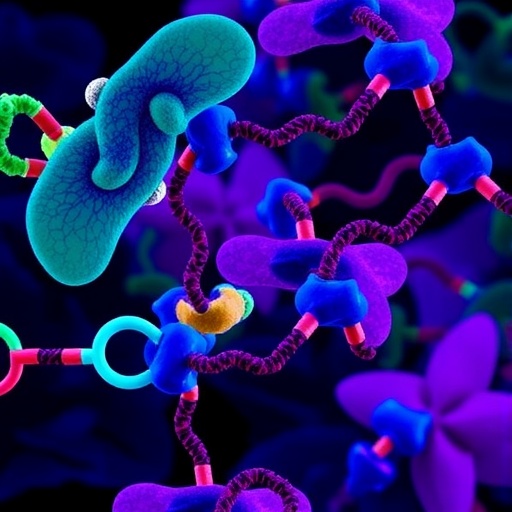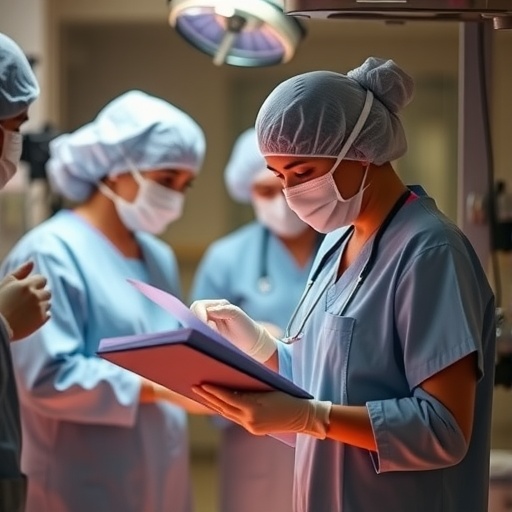
Credit: Photo provided by Michelle Cilia
ITHACA, NY– While searching for a potential Achilles' heel in the insect responsible for spreading the bacterium that causes citrus greening disease, researchers have uncovered a protein that makes their bellies blue and may impact how easily they spread the pathogen.
Asian citrus psyllids with blue abdomens have high levels of an oxygen-transporting protein called hemocyanin, which is commonly found in the blood of crustaceans and mollusks. When harboring the bacterium that causes citrus greening, the psyllids ramp up their production of the protein. Michelle Cilia, a Research Molecular Biologist at the USDA Agricultural Research Service and Assistant Professor at the Boyce Thompson Institute (BTI), and her team of researchers suspect that hemocyanin may be involved in the insect's attempt to fight off the infection. They published their findings in Royal Society Open Science.
Citrus greening disease is an infection that is having a devastating impact on the citrus industry in Florida, where growers report the lowest citrus production in 50 years. The disease is caused by the bacterium Candidatus Liberibacter asiaticus (CLas) and spread by the Asian citrus psyllid. Cilia and her colleagues are exploring a number of novel ways to combat the CLas bacterium.
Together, with colleagues at the University of Washington and the USDA ARS at Fort Pierce, Fla., Cilia lab scientists identified important protein interactions that must occur to perpetuate the transmission of CLas to new trees. They examined interactions occurring between the psyllid and the bacterium, and between the psyllid and its beneficial microbial partners. They also compared protein expression levels in both nymphs and adults. Their research shows that adult psyllids appear to mount a better immune response to CLas as compared to nymphs, which may explain why psyllids must acquire CLas during the nymphal stage to efficiently transmit CLas once they become adults.
"For many decades, scientists lacked the ability to look inside insects that transmit plant pathogens and understand what is going on," said Cilia. "This is no longer true today, thanks to the painstaking work of our collaborators in the Bruce and MacCoss labs at the University of Washington. The new molecular tools developed by our University of Washington colleagues enable us to dissect the vector-pathogen relationship piece by piece to determine which components are important for transmission."
They found that one of the most highly expressed proteins in adult psyllids infected with CLas is a hemocyanin. The protein causes horseshoe crabs to have blue blood, but had never been seen in this group of insects before. Cilia lab researchers showed that the level of hemocyanin present in a psyllid's body also affects its coloration, creating three different "color morphs," blue, gray and yellow.
The group showed that hemocyanin interacts with a CLas protein involved in a vital microbial metabolic pathway called the acetyl-CoA pathway. Scientists have previously targeted this set of biochemical reactions in bacteria when developing antibiotics. John Ramsey, a USDA ARS postdoctoral associate in the Cilia lab and first author of the study, suspects that the increase in hemocyanin, and the blue color it imparts to the abdomen, could be evidence of an immune response to CLas infection. The findings raise the possibility that this response could be harnessed to help control the bacterium's spread.
"The study is allowing you to look at your population of insects and say something about the immune system of the insect based on its color," said Ramsey. "There's the possibility that this could be a useful part of grove surveillance."
In future work, the Cilia group plans to test whether there are differences in each color morph's ability to spread the CLas bacterium. Results from this study will help inform future strategies to control citrus greening disease. Depending on which proteins they decide to target, these new approaches could prevent the psyllid from transmitting CLas or trigger an immune response against the bacterium.
This approach to controlling citrus greening, by blocking bacterial transmission by the psyllid, runs contrary to existing 'kill the insect' strategies, said Ramsey. Such an approach may provide a longer lasting solution because the insect isn't under pressure to evolve to survive the treatment, which commonly occurs with pesticide usage.
###
Research reported in this news release was supported by the Citrus Research Board grants 5300-155 and 5300-163, USDA NIFA grants 2015-70016-23028 and 2016-70016-24779 and USDA ARS projects 6034-22320-001-00 and 8062-22000-021-00.
URL upon publication: http://rsos.royalsocietypublishing.org/lookup/doi/10.1098/rsos.160545
DOI: https://doi.org/10.1098/rsos.160545
Media Relations Contacts:
Keith Hannon
[email protected]
Phone: 607-254-4253
Boyce Thompson Institute
533 Tower Road
Ithaca, New York 14853 USA
To learn more about Boyce Thompson Institute (BTI) research, visit the BTI website at http://bti.cornell.edu.
Connect online with BTI at http://www.facebook.com/BoyceThompsonInstitute and http://www.twitter.com/BTIScience.
About Boyce Thompson Institute
Boyce Thompson Institute is a premier life sciences research institution located in Ithaca, New York on the Cornell University campus. BTI scientists conduct investigations into fundamental plant and life sciences research with the goals of increasing food security, improving environmental sustainability in agriculture and making basic discoveries that will enhance human health.
BTI employs 150 staff, with scientists from 40 countries around the world and has twice been named as one of the Best Companies in New York State. Its 15 principal investigators are leading minds in plant development, chemical ecology, microbiology and plant pathology, and have access to the institute's state-of-the-art greenhouse facilities with computerized controls and a system of integrated pest management. BTI has one of the largest concentrations of plant bioinformaticists in the U.S., with researchers who work across the entire spectrum of "omics" fields. BTI researchers consistently receive funding from NSF, NIH, USDA and DOE and publish in top-tier journals. Throughout its work, BTI is committed to inspiring and educating students and to providing advanced training for the next generation of scientists. For more information, visit http://www.bti.cornell.edu.
Media Contact
Keith Hannon
[email protected]
607-254-4253
@BTIscience
http://bti.cornell.edu
############
Story Source: Materials provided by Scienmag





